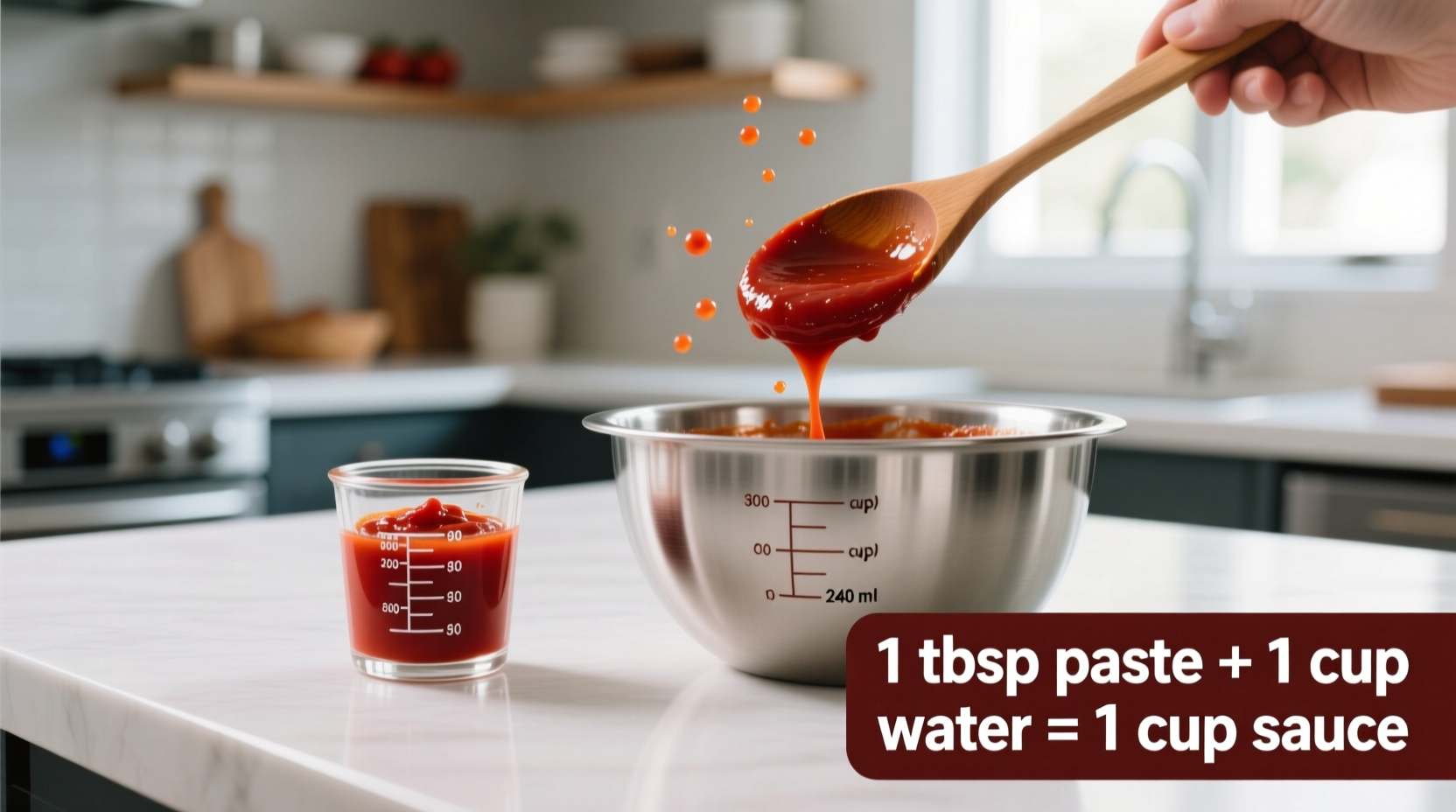Why This Conversion Works: The Science Behind Tomato Concentration
Tomato paste undergoes an extensive cooking process that removes approximately 80% of its original water content. According to USDA food processing standards, this concentration creates a product with 24-30% solids content compared to regular tomato sauce's 8-12% solids. When you add water back to tomato paste, you're essentially reversing this industrial concentration process.
Your Step-by-Step Conversion Guide
Follow this professional kitchen method for perfect results every time:
Step 1: Measure Your Base Ratio
Start with the fundamental ratio that forms the foundation of this conversion:
| Tomato Paste | Water | Resulting Sauce Volume |
|---|---|---|
| ¼ cup (60ml) | ½-¾ cup (120-180ml) | ¾-1 cup (180-240ml) |
| ½ cup (120ml) | 1-1½ cups (240-360ml) | 1½-2 cups (360-480ml) |
| 1 cup (240ml) | 2-3 cups (480-720ml) | 3-4 cups (720-960ml) |
Step 2: Proper Mixing Technique
Never pour water directly into the paste. Instead:
- Place tomato paste in your cooking vessel
- Add a small amount of water (2-3 tablespoons)
- Whisk vigorously until smooth
- Gradually incorporate remaining water
This prevents lumps and ensures even reconstitution. The Food and Drug Administration confirms that proper hydration is critical for food safety when modifying concentrated products.
Step 3: Flavor Enhancement
Basic reconstituted sauce needs seasoning to match commercial products. Add these elements:
- 1 teaspoon olive oil per cup of sauce
- ¼ teaspoon garlic powder per cup
- Pinch of sugar to balance acidity
- ½ teaspoon dried herbs (basil, oregano, or Italian blend)
- Salt to taste (start with ⅛ teaspoon per cup)

When This Method Works Best (And Limitations)
This conversion technique excels in specific cooking scenarios but has important boundaries:
Ideal Applications
- As a base for meat sauces and stews
- In baked pasta dishes requiring thick sauce
- When making pizza sauce
- Emergency substitution in recipes calling for tomato sauce
Limitations to Consider
- Not suitable for fresh tomato salads or cold applications
- Lacks the subtle flavor complexity of slow-cooked sauce
- May require additional thickening for certain recipes
- Won't replicate specialty sauces like arrabbiata or marinara
Pro Tips for Perfect Results
Professional chefs use these techniques to elevate your homemade sauce:
- Simmer for depth: Cook your reconstituted sauce for 15-20 minutes to develop richer flavor
- Acidity balance: Add a small pinch of baking soda if the sauce tastes too acidic
- Texture control: Use less water (1:2 ratio) for pizza sauce, more water (1:3 ratio) for pasta sauce
- Flavor boost: Sauté onions and garlic in olive oil before adding your reconstituted sauce
Storage Guidelines for Your Homemade Sauce
Proper storage ensures food safety and maintains quality:
- Cool completely before refrigerating
- Store in airtight container for up to 5 days
- Freeze in portion-sized containers for up to 3 months
- Always reheat to 165°F (74°C) before serving
The National Center for Home Food Preservation confirms that properly stored tomato-based sauces maintain safety and quality within these timeframes.
Tomato Product Comparison: Understanding Your Options
Knowing the differences helps you make informed substitutions:
| Product | Solids Content | Water Ratio | Best Uses |
|---|---|---|---|
| Tomato Paste | 24-30% | N/A (concentrate) | Base for sauces, soups, stews |
| Tomato Sauce | 8-12% | 1:0 (ready-to-use) | Pasta dishes, pizza, casseroles |
| Tomato Puree | 10-12% | 1:1.5 (paste:water) | Soups, stews, braises |
| Crushed Tomatoes | 8-10% | N/A | Chunky sauces, rustic dishes |
Common Questions About Tomato Paste Conversion
Here are answers to frequently asked questions about making tomato sauce from paste:











 浙公网安备
33010002000092号
浙公网安备
33010002000092号 浙B2-20120091-4
浙B2-20120091-4